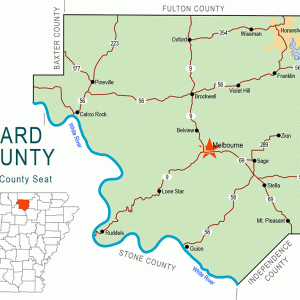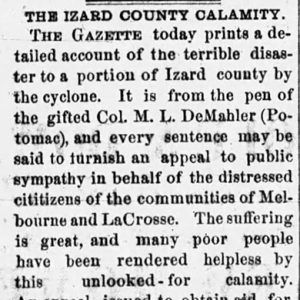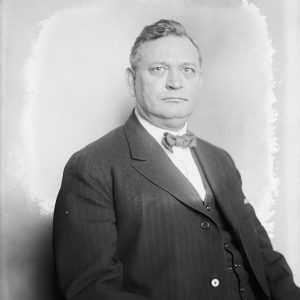calsfoundation@cals.org
LaCrosse (Izard County)
The community of LaCrosse in the twenty-first century is practically a ghost town, with only a few occupied houses remaining. This is a striking contrast to earlier decades, when it was a bustling small town, with the LaCrosse Collegiate Institute having a statewide reputation.
Located in rolling prairie land, that area of Izard County was first settled in 1845 by three brothers: William Frederick Watkins, James Davis Watkins, and Dr. Owen Thomas Watkins, a graduate of the Medical College at Louisville, Kentucky. The brothers were natives of Tennessee. Land patent records reveal their far-reaching land acquisitions, which extended into Fulton, Sharp, and Independence counties. Their farming ventures included cotton, cattle, blooded horses, hogs, and cotton ginning. Dr. Owen Watkins’s practice extended from present-day Stone County north to the Missouri state boundary and from near Batesville (Independence County) northwest to Marion County. His method of travel was, at first, horseback. Seeing the need for additional public roads, he set his slaves to work on building short cuts through the region at his own expense.
The large home built by the Watkins family housed an extended family of nieces, nephews, and three generations of Watkins descendants. It was built of bricks hand-formed by the slaves, who also had brick houses.
The doctor urged his brother, James Watkins, to run for the Arkansas General Assembly. James Watkins won the election in 1848 and represented Izard and Independence counties in the state Senate from 1848 through 1851.
A post office was established in 1848 at what was then called Wild Haws, so named because of the large number of haw trees about two miles away at Franklin (Izard County), but the post office department in Washington DC switched the names of Franklin and Wild Haws. During the Civil War, Union soldiers traversed the area during what is now called the Wild Haws Expedition, before the name Wild Haws was changed to LaCrosse in 1869.
According to the 1860 census, the Watkins brothers owned twenty-two slaves, more than anybody else in the county except Thomas Black, who also owned twenty-two. Descendants of the slaves grew up in LaCrosse, which was home to Izard County’s largest black community, as well as one of the largest black communities in the rural Ozark Mountains. In the 1930s and 1940s, many of the black families moved to Batesville, where some of their descendants still reside in the twenty-first century.
The LaCrosse Collegiate Institute was established in 1868 by Michael Shelby Kennard; it remained in operation until 1902, although Kennard sporadically had to accept teaching positions in other towns. The first newspaper in the county was established by James H. Graham in 1873. Named the LaCrosse Post, it lasted until 1876, when Graham moved it to Melbourne (Izard County).
When Izard County lost its area south and west of the White River to Stone County in 1873, most of the residents wanted to move the county seat to a more central location. In the 1875 election, LaCrosse campaigned for the honor, with Ray Davis arguing that it was an established town “with an academy of state-wide reputation, a number of churches, several doctors and lawyers, good stores, and other services.” Mill Creek (what is now Melbourne) campaigned on the basis that it was more centrally located. LaCrosse lost that election by only a few votes.
During the early morning hours of November 21, 1883, Izard County was struck by a destructive tornado. At Lacrosse, the deadly storm killed at least two people and injured almost 150 more in the surrounding area. More than thirty houses, five businesses, two churches, the Masonic Hall, and collegiate academy were destroyed. Only five houses remained, and little else was left standing once the storm had passed.
In 1889, Goodspeed’s history described the village thusly: “LaCrosse, four miles northeast of Melbourne, contains two general stores, a drug store, a church edifice, two blacksmith shops, a Masonic Hall and Lodge, and the LaCrosse Collegiate Institute.” It also said that a Methodist Episcopal Church South congregation, a Cumberland Presbyterian church, and an Adventist church were located at LaCrosse. The Baptist church was in Philadelphia (Izard County), about two miles from LaCrosse.
In 1925, the one remaining store was bought by P. O. Wren, as recalled by P. O. Wren Jr. in a 1989 interview. It remained open until 1988, when the post office at LaCrosse was discontinued. The store building is still standing at the intersection of two county roads as of 2012.
The most well-known residents of LaCrosse were the Watkins brothers; Professor Michael Shelby Kennard, the head teacher at the LaCrosse Collegiate Institute, who taught college-level classes to hundreds of students; and William A. Oldfield, U.S. representative for the Second Congressional District from 1909 until his November 19, 1928, death. In 2010, Tommy Wren of LaCrosse, a relative of P. O. Wren, was elected to represent District 62 in the state legislature, which includes part of Izard County.
For additional information:
Biographical and Historical Memoirs of Northeast Arkansas. Chicago: Goodspeed Publishing Co., 1891.
Blevins, Brooks. “Izard County Poverty and Racial Harmony.” Independence County Chronicle 33 (April–July 1992): 29–36.
———. “Revisiting Race Relations in an Upland South Community: LaCrosse, Arkansas.” In History and Hope in the Heart of Dixie: Scholarship, Activism, and Wayne Flynt in the Modern South, edited by Gordon Harvey, Richard Starnes, and Glenn Feldman. Tuscaloosa: University of Alabama Press, 2006.
Johnson, Velma Cypert. “Aunt Lucy Johnson, Ninety-six Years a Resident of Arkansas.” Izard County Historian 12 (October 1981): 25–31.
Lindley, Helen C. “The Watkins Brothers and Wild Haws.” Izard County Historian 3 (October 1974): 2–21.
McCollum, Betty Guthrie, and Sue Shell Chrisco, compilers. Down Memory Lane II. N.p.: 2000.
Shannon, Karr. A History of Izard County. Little Rock: Democrat Printing and Lithographing Co., 1947.
Mary Cooper Miller
Izard County Historical Society
 Maddox, Finis Ewing
Maddox, Finis Ewing Izard County Map
Izard County Map  LaCrosse Tornado Article
LaCrosse Tornado Article  William A. Oldfield
William A. Oldfield 



My great-grandfather was Dr. O. T. Watkins. I loved reading about him in this article. I have an original letter from 1864, during the Civil War, granting Dr. Watkins the right to pass and “exempted “signed by Wm. C. Kelly, “Officer for Izard County.” It says “guards and pickets will let him pass.” It is dated Aug. 1, 1864. The letter was sent to him c/o Lacrosse, AR, .and Googling the city brought up this article because the Watkins family established the city. My father, John N. Watkins was Dr. Watkins’s grandson.